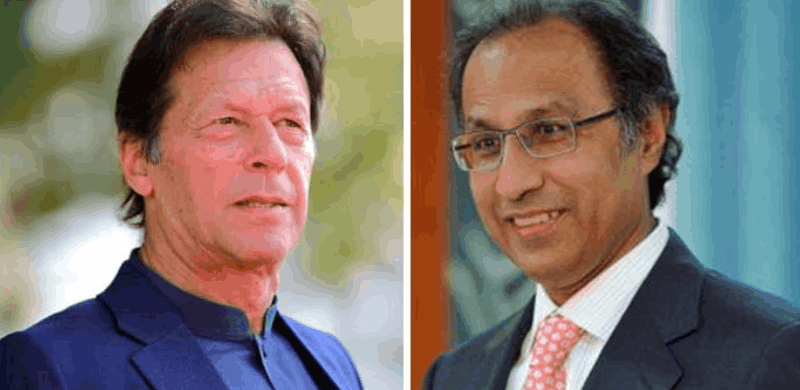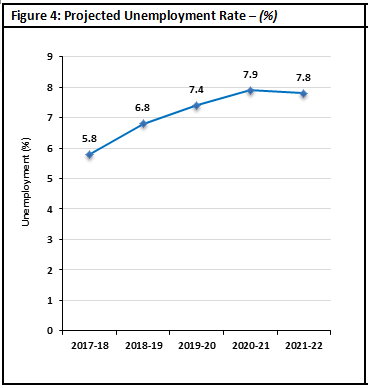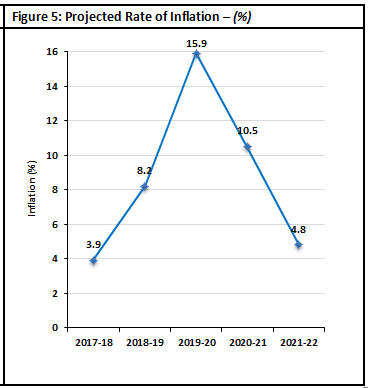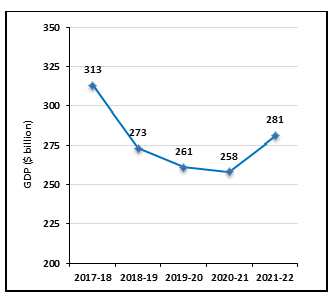
A new report by leading economists -- Dr. Hafiz A. Pasha, Shahid Kardar and Muhammad Imran -- indicates that Pakistan is headed towards an economic downturn, higher levels of inflation, unemployment and poverty. The impact of IMF programme that the government has agreed to will have severe economic, social and political ramifications.
Rate of UnemploymentThe report mentions that with low GDP growth and a decline in investment levels, there will be an increase in the number of unemployed people to 5.6 million by 2021-22. The cumulative number of jobs created over the four year period, 2018-19 to 2021-22, is 5 million, as compared to the increase in the labor force of 6.9 million.
"The PTI's commitment of creating 2 million jobs annually will appear to be a distant pipedream. In fact, the unemployment rate is expected to rise from 5.8 percent in 2017-18 to almost 8 percent by 2020-21. It may fall somewhat in 2021-22 if the economy attains a growth rate of 4.5 percent or more."
Rate of UnemploymentThe report mentions that with low GDP growth and a decline in investment levels, there will be an increase in the number of unemployed people to 5.6 million by 2021-22. The cumulative number of jobs created over the four year period, 2018-19 to 2021-22, is 5 million, as compared to the increase in the labor force of 6.9 million.
"The PTI's commitment of creating 2 million jobs annually will appear to be a distant pipedream. In fact, the unemployment rate is expected to rise from 5.8 percent in 2017-18 to almost 8 percent by 2020-21. It may fall somewhat in 2021-22 if the economy attains a growth rate of 4.5 percent or more."
 Rate of Inflation
Rate of InflationThe monthly average of the year-to-year rate of inflation in the consumer price index is estimated at 8.2 percent in 2018-19, according to the report. The increase in inflation is due to the depreciation in the value of the rupee and high digital inflation is expected by 2019-20.
"This will be due to the spread and deepening of inflationary expectations as well as the rise in prices of imported products due to the continuation of the process of depreciation of the rupee and higher burden of indirect taxes".

Level of GDP
The sharp devaluation of the rupee at a rate generally faster than the rise in the implicit GDP deflator will lead to a hitherto unprecedented situation where the GDP starts falling in terms of US$ from 2018-19 onwards up to 2021-22. The estimated GDP in 2021-22 will be at $281 billion, which is lower than that in 2017-18, which was $313 billion.
Moreover, the report said that the per capita income might also decrease to $1300, which is lower than that of Bangladesh.
Incidence of Poverty
From 2018-19 to 2020-21, more people will fall below the poverty line, the report predicts. The number of poor people will increase by 4 million in 2018-19, and by 5.2 million in 2019-20. By 2020-21, there will be an increase of 3.6 million in the number of poor people and by 0.4 million in 2021-22.
"Cumulatively the number of people falling below the poverty line during the IMF EFF to Pakistan is over 9 million, equivalent to an increase in the incidence of poverty of almost 4.5 percentage points," the report said.

Overall, the process of stabilization under the umbrella of a three-year IMF Program could impose enormous strain on the economy and on the people of Pakistan, in the first two years, 2019-20 and 2020-21.
The GDP growth rate is likely to be low, the investment will plummet downwards, the rate of inflation will rise and the level of unemployment and the number of poor people will increase perceptibly."
